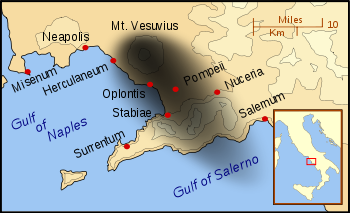
Oplontis
Encyclopedia

Pompeii
The city of Pompeii is a partially buried Roman town-city near modern Naples in the Italian region of Campania, in the territory of the comune of Pompei. Along with Herculaneum, Pompeii was destroyed and completely buried during a long catastrophic eruption of the volcano Mount Vesuvius spanning...
, in the Roman Empire
Roman Empire
The Roman Empire was the post-Republican period of the ancient Roman civilization, characterised by an autocratic form of government and large territorial holdings in Europe and around the Mediterranean....
. On August 24, AD 79, the eruption of Mount Vesuvius
Mount Vesuvius
Mount Vesuvius is a stratovolcano in the Gulf of Naples, Italy, about east of Naples and a short distance from the shore. It is the only volcano on the European mainland to have erupted within the last hundred years, although it is not currently erupting...
buried it under a deep layer of ash. It is today the location of the Villa Poppaea
Villa Poppaea
The Villa Poppaea is a Roman villa situated between Naples and Sorrento, in southern Italy, which dates from the early Imperial times.The villa is a large structure situated in the Roman town of Oplontis , about ten metres below the modern level...
, the villa of the wife of Emperor Nero, which was excavated in the mid-20th century and is open to the public.
A second villa, the Villa of L. Crassius Tertius, was discovered in 1974, 250 metres east of the Villa of Poppaea, during the construction of a school. It was named following the finding of a bronze seal bearing Crassius' name.
The name "Oplontis" most likely refers to the baths in the area of Oncino, but today the name commonly covers the group of villas in the middle of the modern town of Torre Annunziata
Torre Annunziata
Torre Annunziata is a city and comune in the province of Naples, region of Campania in Italy. It is located at the Gulf of Naples at the foot of Mt. Vesuvius.-History:...
, also known as Torre Nunziata in the local Neapolitan
Neapolitan language
Neapolitan is the language of the city and region of Naples , and Campania. On October 14, 2008 a law by the Region of Campania stated that the Neapolitan language had to be protected....
dialect.
A large number of artifacts
Artifact (archaeology)
An artifact or artefact is "something made or given shape by man, such as a tool or a work of art, esp an object of archaeological interest"...
from Oplontis are preserved in the Naples National Archaeological Museum
Naples National Archaeological Museum
The Naples National Archaeological Museum is a museum in Naples, southern Italy, at the northwest corner of the original Greek wall of the city of Neapolis. The museum contains a large collection of Roman artifacts from Pompeii, Stabiae and Herculaneum...
.

